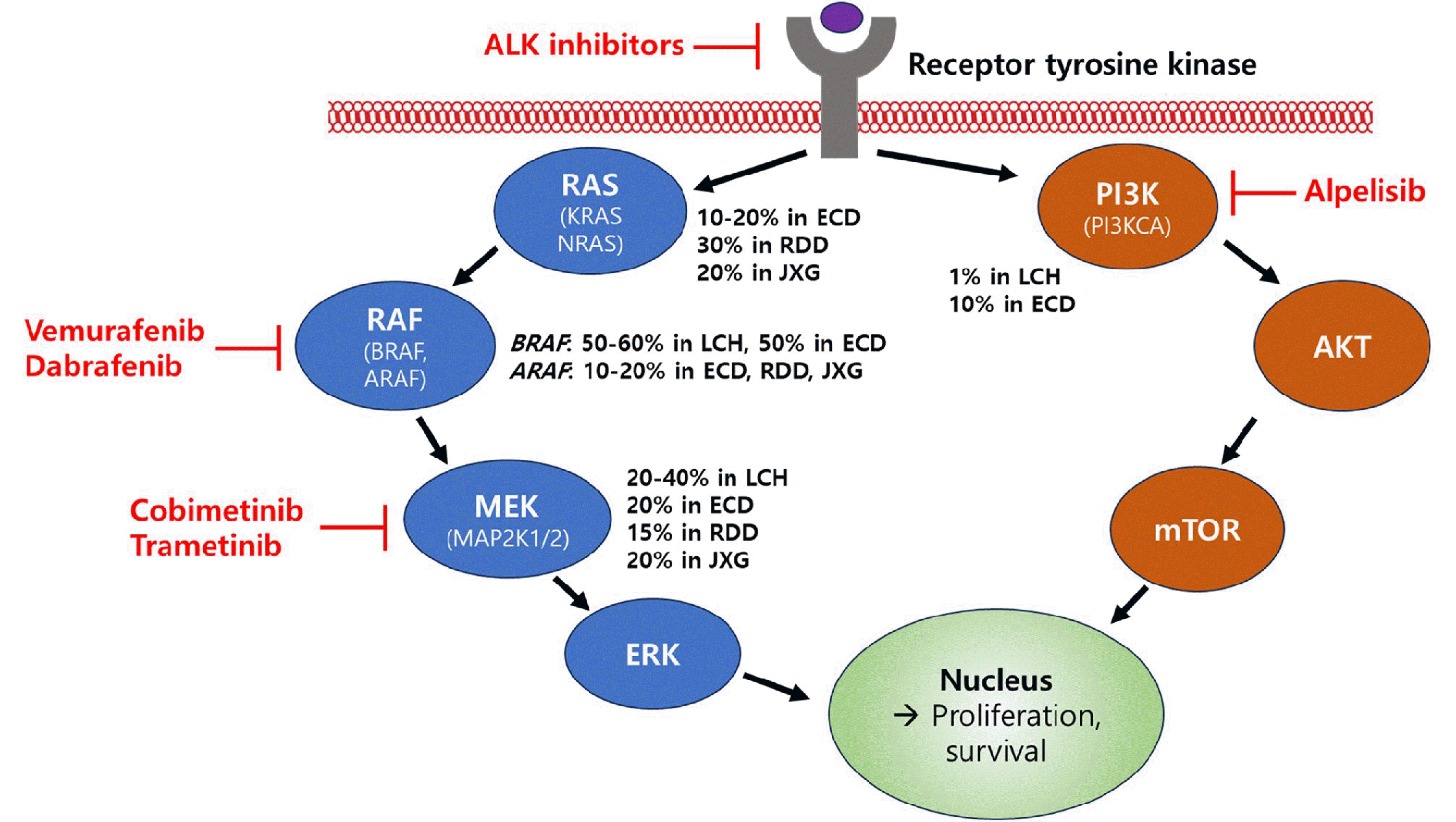1. Emile JF, Abla O, Fraitag S, et al. 2016; Revised classification of histiocytoses and neoplasms of the macrophage-dendritic cell lineages. Blood. 127:2672–81. DOI:
10.1182/blood-2016-01-690636. PMID:
26966089. PMCID:
PMC5161007.
2. Go RS, Jacobsen E, Baiocchi R, et al. 2021; Histiocytic neoplasms, version 2.2021, NCCN clinical practice guidelines in oncology. J Natl Compr Canc Netw. 19:1277–303. DOI:
10.6004/jnccn.2021.0053. PMID:
34781268.
3. Durham BH. 2019; Molecular characterization of the histiocytoses: neoplasia of dendritic cells and macrophages. Semin Cell Dev Biol. 86:62–76. DOI:
10.1016/j.semcdb.2018.03.002. PMID:
29526544.

4. Suh JK, Kang S, Kim H, Im HJ, Koh KN. 2021; Recent advances in the understanding of the molecular pathogenesis and targeted therapy options in Langerhans cell histiocytosis. Blood Res. 56:S65–9. DOI:
10.5045/br.2021.2021013. PMID:
33935037. PMCID:
PMC8093998.

5. Kemps PG, Hebeda KM, Pals ST, et al. 2021; Spectrum of histiocytic neoplasms associated with diverse haematological malignancies bearing the same oncogenic mutation. J Pathol Clin Res. 7:10–26. DOI:
10.1002/cjp2.177. PMID:
32852896. PMCID:
PMC7737785.

7. Khoury JD, Solary E, Abla O, et al. 2022; The 5th edition of the World Health Organization classification of haematolymphoid tumours: myeloid and histiocytic/dendritic neoplasms. Leukemia. 36:1703–19. DOI:
10.1038/s41375-022-01613-1. PMID:
35732831. PMCID:
PMC9252913.

8. Writing Group of the Histiocyte Society. 1987; Histiocytosis syndromes in children. Lancet. 1:208–9.
9. Goyal G, Heaney ML, Collin M, et al. 2020; Erdheim-Chester disease: consensus recommendations for evaluation, diagnosis, and treatment in the molecular era. Blood. 135:1929–45. DOI:
10.1182/blood.2019003507. PMID:
32187362.

11. Minkov M. 2018; The, "rare" or "non-LCH" histiocytic disorders in childhood: a brief overview. Iran J Blood Cancer. 10:101–7. DOI:
10.1007/978-3-319-59632-7.
12. Haroche J, Abla O. 2015; Uncommon histiocytic disorders: Rosai-Dorfman, juvenile xanthogranuloma, and Erdheim-Chester disease. Hematol Am Soc Hematol Educ Program. 2015:571–8. DOI:
10.1182/asheducation-2015.1.571. PMID:
26637774.
13. Foucar E, Rosai J, Dorfman R. 1990; Sinus histiocytosis with massive lymphadenopathy (Rosai-Dorfman disease): review of the entity. Semin Diagn Pathol. 7:19–73.
15. Haroche J, Charlotte F, Arnaud L, et al. 2012; High prevalence of BRAF V600E mutations in Erdheim-Chester disease but not in other non-Langerhans cell histiocytoses. Blood. 120:2700–3. DOI:
10.1182/blood-2012-05-430140. PMID:
22879539.

17. Nelson DS, van Halteren A, Quispel WT, et al. 2015; MAP2K1 and MAP3K1 mutations in Langerhans cell histiocytosis. Genes Chromosomes Cancer. 54:361–8. DOI:
10.1002/gcc.22247. PMID:
25899310.
18. Alayed K, Medeiros LJ, Patel KP, et al. 2016; BRAF and MAP2K1 mutations in Langerhans cell histiocytosis: a study of 50 cases. Hum Pathol. 52:61–7. DOI:
10.1016/j.humpath.2015.12.029. PMID:
26980021.

20. Kordes M, Roring M, Heining C, et al. 2016; Cooperation of BRAF(F595L) and mutant HRAS in histiocytic sarcoma provides new insights into oncogenic BRAF signaling. Leukemia. 30:937–46. DOI:
10.1038/leu.2015.319. PMID:
26582644.

21. Xu J, Huang X, Wen Y, et al. 2023; Systemic juvenile xanthogranuloma has a higher frequency of ALK translocations than BRAFV600E mutations. J Am Acad Dermatol. 88:656–9. DOI:
10.1016/j.jaad.2020.08.053. PMID:
32822792.

24. Brown NA, Furtado LV, Betz BL, et al. 2014; High prevalence of somatic MAP2K1 mutations in BRAF V600E-negative Langerhans cell histiocytosis. Blood. 124:1655–8. DOI:
10.1182/blood-2014-05-577361. PMID:
24982505.

26. Kemps PG, Zondag TCE, Arnardottir HB, et al. 2023; Clinicogenomic associations in childhood Langerhans cell histiocytosis: an international cohort study. Blood Adv. 7:664–79. DOI:
10.1182/bloodadvances.2022007947. PMID:
36083130. PMCID:
PMC9979766.

28. Diamond EL, Abdel-Wahab O, Pentsova E, et al. 2013; Detection of an NRAS mutation in Erdheim-Chester disease. Blood. 122:1089–91. DOI:
10.1182/blood-2013-02-482984. PMID:
23929840.

30. Chan JK, Lamant L, Algar E, et al. 2008; ALK+ histiocytosis: a novel type of systemic histiocytic proliferative disorder of early infancy. Blood. 112:2965–8. DOI:
10.1182/blood-2008-03-147017. PMID:
18660380.

31. Kemps PG, Picarsic J, Durham BH, et al. 2022; ALK-positive histiocytosis: a new clinicopathologic spectrum highlighting neurologic involvement and responses to ALK inhibition. Blood. 139:256–80. DOI:
10.1182/blood.2021013338. PMID:
34727172. PMCID:
PMC8759533.
32. Yoon SH, Kang SH, Kim H, et al. 2024; Successful treatment of relapsed disseminated juvenile xanthogranuloma with central nervous system involvement. Clin Pediatr Hematol Oncol. 31:Online ahead of print. DOI:
10.32388/fsqr39.
33. Koh YK, Yoon SH, Kang SH, et al. 2022; Improvement of neurodegenerative disease after use of vemurafenib in refractory BRAF V600E-mutated Langerhans cell histiocytosis: a case report. Clin Pediatr Hematol Oncol. 29:97–101. DOI:
10.15264/cpho.2022.29.2.97. PMID:
81ef410bb3204df09ecbdae0068c45f3.

34. Donadieu J, Larabi IA, Tardieu M, et al. 2019; Vemurafenib for refractory multisystem Langerhans cell histiocytosis in children: an international observational study. J Clin Oncol. 37:2857–65. DOI:
10.1200/JCO.19.00456. PMID:
31513482. PMCID:
PMC6823889.

35. Yang Y, Wang D, Cui L, et al. 2021; Effectiveness and safety of dabrafenib in the treatment of 20 Chinese children with BRAFV600E-mutated Langerhans cell histiocytosis. Cancer Res Treat. 53:261–9. DOI:
10.4143/crt.2020.769. PMID:
32972045. PMCID:
PMC7812025.

36. Collin M. 2023; Histiocytic neoplasms: going, going, but not quite gone. Br J Haematol. 203:347–8. DOI:
10.1111/bjh.19014. PMID:
37592718.

38. Reiner AS, Durham BH, Yabe M, et al. 2023; Outcomes after interruption of targeted therapy in patients with histiocytic neoplasms. Br J Haematol. 203:389–94. DOI:
10.1111/bjh.18964. PMID:
37400251.

40. Cohen Aubart F, Emile JF, Maksud P, et al. 2018; Efficacy of the MEK inhibitor cobimetinib for wild-type BRAF Erdheim-Chester disease. Br J Haematol. 180:150–3. DOI:
10.1111/bjh.14284. PMID:
27711968.






 PDF
PDF Citation
Citation Print
Print


 XML Download
XML Download